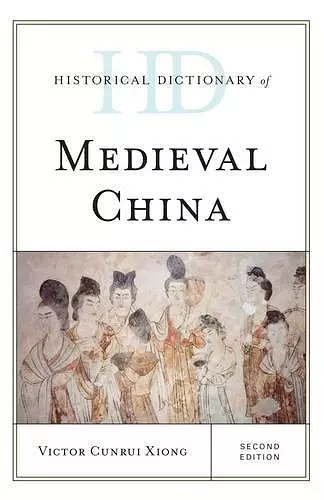Historical Dictionary of Medieval China
Format:Hardback
Publisher:Rowman & Littlefield
Published:6th Jun '17
Currently unavailable, and unfortunately no date known when it will be back

The crucial period of Chinese history, 168-979, falls naturally into contrasting phases. The first phase, also known as that of 'early medieval China,' is an age of political decentralization. Following the breakup of the Han empire, China was plunged into civil war and fragmentation and stayed divided for nearly four centuries. The second phase started in 589, during the Sui dynasty, when China was once again brought under a single government. Under the Sui, the bureaucracy was revitalized, the military strengthened, and the taxation system reformed. The fall of the Sui in 618 gave way to the even stronger Tang dynasty, which represents an apogee of traditional Chinese civilization. Inheriting all the great institutions developed under the Sui, the Tang made great achievements in poetry, painting, music, and architecture. The An Lushan rebellion, which also took place during Tang rule, brought about far-reaching changes in the socioeconomic, political, and military arenas. What transpired in the second half of the Tang and the ensuing Five Dynasties provided the foundation for the next age of late imperial China. This second edition of Historical Dictionary of Medieval China contains a chronology, an introduction, and an extensive bibliography. The dictionary section has over 1000 cross-referenced entries on historical figure. It expands on existing thematic entries, and adds a number of new ones with substantial content, including those on nobility, art, architecture, archaeology, economy, agriculture, money, population, cities, literature, historiography, military, religion, Persia, India, Japan, Korea, Arabs, and Byzantium, among others. This book is an excellent access point for students, researchers, and anyone wanting to know more about medieval China.
Covering an extensive period—from the end of Han in the late second century to the beginning of Song in the late tenth—this updated edition features historical figures, places, events, movements, agencies and offices, works of art and literature, and more. The volume contains maps of China during the various dynastic periods, a lengthy introduction, a chronology, and other supporting materials. Historian Xiong author of Emperor Yang of the Sui Dynasty: His Life, Times, and Legacy, has added more than 1,500 new entries with extensive cross-references to the approximately 5,000 entries of the 2009 first edition (reissued in paperback as The A to Z of Medieval China in 2010). The author has also expanded the chronology and updated the bibliography with recent scholarship. Entries are typically a few lines to a half page long, and each provides the Chinese characters for the term, approximate dates when relevant, geographical area, a brief definition or explanation, and reference to Chinese sources when applicable. Thematic entries, many new in this second edition, are longer—from a half page (e.g., ‘nobility’) to three pages (e.g., ‘literature’). The work is a commendable undertaking and a valuable reference tool for Chinese studies. Summing Up: Recommended. Advanced students through researchers/faculty. * CHOICE *
This two-volume book is now in its second edition, and is perhaps the most comprehensive dictionary on medieval China available. Over 1,500 new entries have been added and errors from the first edition have been corrected. More coverage of county and local governments has been included, more historical figures added, substantial thematic content on a number of topics has been expanded, homonymic place-names have been separated, extensive cross-references with see and see also related terms are now available, the chronology and the bibliography have been lengthened, and a pronunciation guide for difficult Chinese characters is now available. Eleven maps are included in the front of the book, along with an extensive index to locate important cities, towns, etc. in medieval China from 262 C.E. to the mid-10th century. An appendix includes the various reigns from the late second century to the 10th century, listed alphabetically rather than chronologically. Overall, this is an essential reference guide to medieval China, and would be appropriate in any college and university library. * American Reference Books Annual *
ISBN: 9781442276154
Dimensions: 238mm x 162mm x 83mm
Weight: 1855g
1006 pages
Second Edition